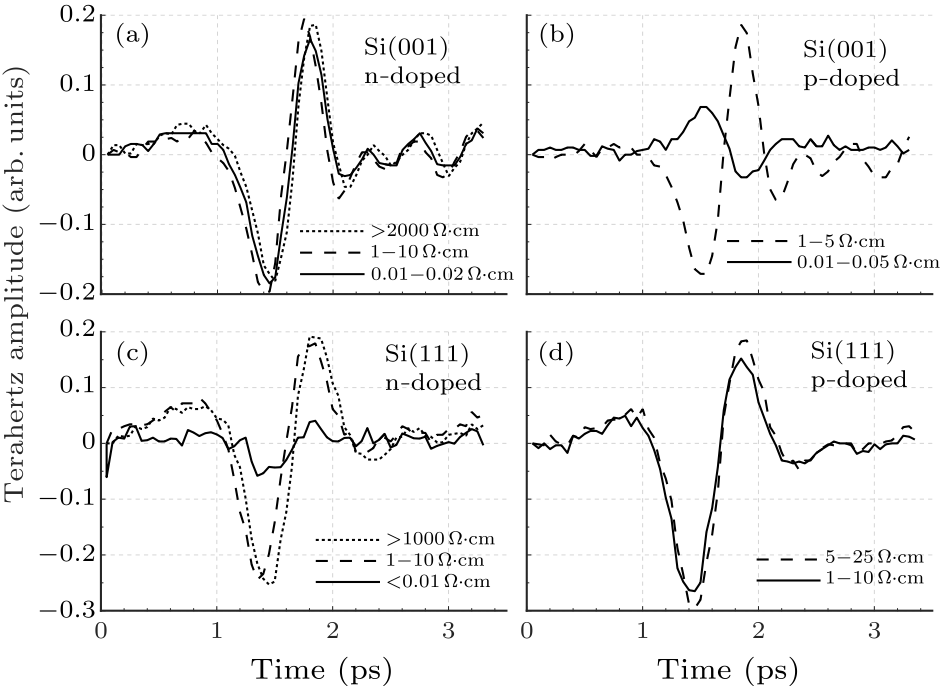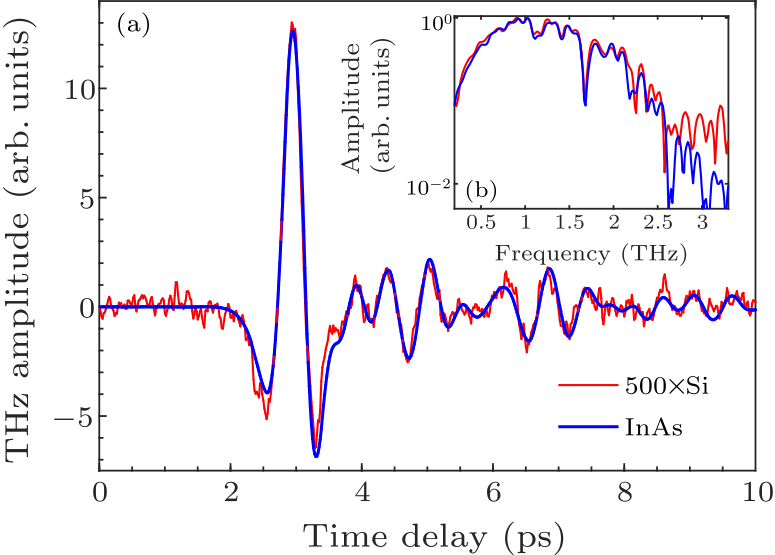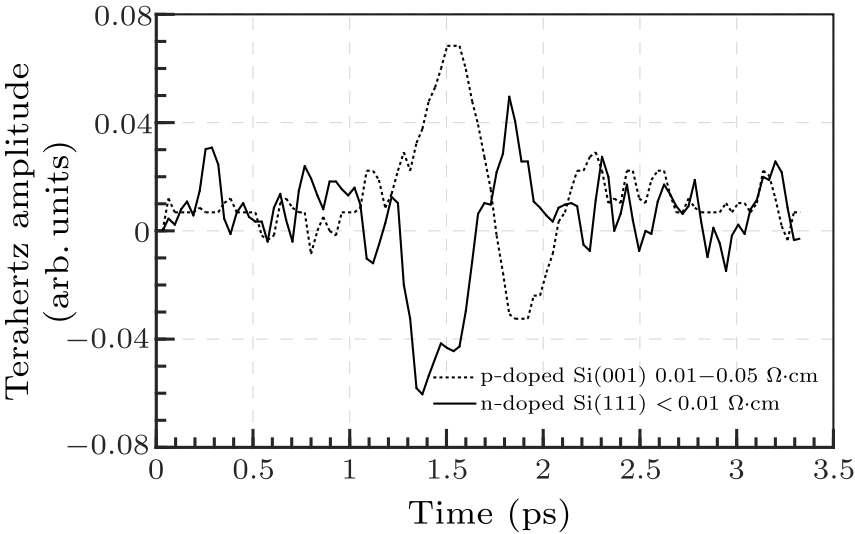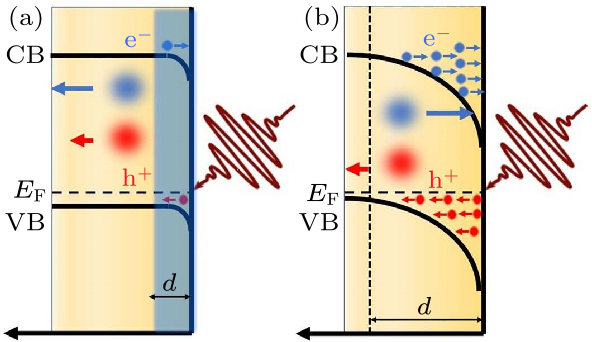
Fig. 1. Terahertz electric-field transients from (a) n-, (b) p-type Si (001) and (c) n-, (d) p-type Si (111) surfaces with different doping concentrations.

Fig. 2. THz electric-field transients (a) and normalized amplitudes (b) from lightly doped n-type Si (111) surface (red line) and p-type InAs wafer (blue line).

Fig. 3. THz electric-field transients from heavily doped p- (dotted line) and n-type (solid line) Si surfaces.

Fig. 4. Peak-to-peak amplitudes of THz electric fields as a function of the azimuthal angle of (a) Si (001) and (b) Si (111) surfaces.

Fig. 5. Optical excitation of hot carriers in lightly (a) and heavily (b) p-doped Si. Photogenerated hot electron-hole (e–h) pairs (blue and red circles, respectively) are separated to a distance $d$ forming a dipole to screen the initial quiescent electronic field at the p-doped Si surfaces. The screen length is thin in (a) shown as the blue region and thick in (b) depicted as the dashed line. The energies of conduction band (CB, horizontal solid line), valence band (VB, horizontal solid line) and Fermi level (EF, horizontal dashed line) are shown. The incident photo (brown arrow) energy is higher than the direct bandgap ($E_{\rm g}$) of Si.
| [1] | Sze S M and Ng K K 2007 Physics of Semiconductor Devices 3rd edn (New Jersey: John Wiley & Sons) p 790 |
| [2] | Fahey P, Griffin P B, and Plummer J D 1989 Rev. Mod. Phys. 61 289 | Point defects and dopant diffusion in silicon
| [3] | Wang W, Lüpke G, Ventra M D, Pantelides S, Gilligan J, Tolk N, Kizilyalli I, Roy P, Margaritondo G, and Lucovsky G 1998 Phys. Rev. Lett. 81 4224 | Coupled Electron-Hole Dynamics at the Interface
| [4] | Bloch J, Mihaychuk J G, and van Driel H M 1996 Phys. Rev. Lett. 77 920 | Electron Photoinjection from Silicon to Ultrathin Si Films via Ambient Oxygen
| [5] | Meyer C, Lüpke G, Emmerichs U, Wolter F, Kurz H, Bjorkman C H, and Lucovsky G 1995 Phys. Rev. Lett. 74 3001 | Electronic Transitions at Si(111)/Si and Si(111)/S Interfaces Studied by Optical Second-Harmonic Spectroscopy
| [6] | Eich S 2017 Sci. Adv. 3 e1602094 | Band structure evolution during the ultrafast ferromagnetic-paramagnetic phase transition in cobalt
| [7] | Lim D, Downer M C, Ekerdt J G, Arzate N, Mendoza B S, Gavrilenko V I, and Wu R Q 2000 Phys. Rev. Lett. 84 3406 | Optical Second Harmonic Spectroscopy of Boron-Reconstructed Si(001)
| [8] | Mihaychuk J G, Shamir N, and van Driel H M 1999 Phys. Rev. B 59 2164 | Multiphoton photoemission and electric-field-induced optical second-harmonic generation as probes of charge transfer across the interface
| [9] | Zhang Y, Guo Q, Zheng S, Zhong X, Zhong G, Zhang D, Ren C, Tan C, Lu Z, Zhang Y, Tang Y, Wang J, and Yuan J 2018 J. Mater. Chem. C 6 11679 | Surface-step-terrace tuned second-order nonlinear optical coefficients of epitaxial ferroelectric BaTiO 3 films
| [10] | Zhang Y, Zhang Y, Guo Q, Zhong X, Chu Y, Lu H, Zhong G, Jiang J, Tan C, Liao M, Lu Z, Zhang D, Wang J, Yuan J, and Zhou Y 2018 npj Comput. Mater. 4 39 | Characterization of domain distributions by second harmonic generation in ferroelectrics
| [11] | Scheidt T, Rohwer E G, von Neethling B H M, and Stafast H 2008 J. Appl. Phys. 104 083712 | Ionization and shielding of interface states in native p+-Si/SiO2 probed by electric field induced second harmonic generation
| [12] | Fiore J L, Fomenko V V, Bodlaki D, and Borguet E 2011 Appl. Phys. Lett. 98 041905 | Second harmonic generation probing of dopant type and density at the Si/SiO2 interface
| [13] | Guo Q, Zhang Y, Lyu Z, Zhang D, Huang Y, Meng C, Zhao Z, and Yuan J 2019 Opt. Mater. Express 9 2376 | Terahertz emission and optical second harmonic generation from Si surfaces
| [14] | Zhang X C, Hu B B, Darrow T J, and Auston D H 1990 Appl. Phys. Lett. 56 1011 | Generation of femtosecond electromagnetic pulses from semiconductor surfaces
| [15] | Zhang X C and Auston D H 1992 J. Appl. Phys. 71 326 | Optoelectronic measurement of semiconductor surfaces and interfaces with femtosecond optics
| [16] | Tonouchi M 2020 J. Appl. Phys. 127 245703 | Simplified formulas for the generation of terahertz waves from semiconductor surfaces excited with a femtosecond laser
| [17] | Ulbricht R, Hendry E, Shan J, Heinz T F, and Bonn M 2011 Rev. Mod. Phys. 83 543 [Erratum: 2017 Rev. Mod. Phys. 89 029901] | Carrier dynamics in semiconductors studied with time-resolved terahertz spectroscopy
| [18] | Yamahara K, Mannan A, Kawayama I, Nakanishi H, and Tonouchi M 2020 Sci. Rep. 10 14633 | Ultrafast spatiotemporal photocarrier dynamics near GaN surfaces studied by terahertz emission spectroscopy
| [19] | Ferguson B and Zhang X C 2002 Nat. Mater. 1 26 | Materials for terahertz science and technology
| [20] | Mochizuki T, Ito A, Mitchell J, Nakanishi H, Tanahashi K, Kawayama I, Tonouchi M, Shirasawa K, and Takato H 2017 Appl. Phys. Lett. 110 163502 | Probing the surface potential of oxidized silicon by assessing terahertz emission
| [21] | Huang Y, Zhu L, Zhao Q, Guo Y, Ren Z, Bai J, and Xu X 2017 ACS Appl. Mater. & Interfaces 9 4956 | Surface Optical Rectification from Layered MoS 2 Crystal by THz Time-Domain Surface Emission Spectroscopy
| [22] | Mochizuki T, Ito A, Nakanishi H, Tanahashi K, Kawayama I, Tonouchi M, Shirasawa K, and Takato H 2019 J. Appl. Phys. 125 151615 | Noncontact evaluation of electrical passivation of oxidized silicon using laser terahertz emission microscope and corona charging
| [23] | Jacobs K, Murakami H, Murakami F, Serita K, Beyne E, and Tonouchi M 2021 Nat. Electron. 4 202 | Characterization of through-silicon vias using laser terahertz emission microscopy
| [24] | Hotta Y, Kawayama I, Miyake S, Saiki I, Nishi S, Yamahara K, Arafune K, Yoshida H, Satoh S, Sawamoto N, Ogura A, Ito A, Nakanishi H, Tonouchi M, and Tabata H 2018 Appl. Phys. Lett. 113 012103 | Control of dipole properties in high-k and SiO 2 stacks on Si substrates with tricolor superstructure
| [25] | Jiang H, Gong C, Nishimura T, Murakami H, Kawayama I, Nakanishi H, and Tonouchi M 2020 Photonics 7 73 | Terahertz Emission Spectroscopy and Microscopy on Ultrawide Bandgap Semiconductor β-Ga2O3
| [26] | Guo Q, Zhang Y, Lyu Z, Z, Huang Y, Meng C, Zhao Z, and Yuan J 2019 IEEE Trans. Terahertz Sci. Technol. 9 422 | THz Time-Domain Spectroscopic Ellipsometry With Simultaneous Measurements of Orthogonal Polarizations
| [27] | Dekorsy T, Pfeifer T, Kütt W, and Kurz H 1993 Phys. Rev. B 47 3842 | Subpicosecond carrier transport in GaAs surface-space-charge fields
| [28] | Johnston M B, Whittaker D M, Corchia A, Davies A G, and Linfield E H 2002 Phys. Rev. B 65 165301 | Simulation of terahertz generation at semiconductor surfaces
| [29] | Heyman J, Coates N, Reinhards A, and Strasser G 2003 Appl. Phys. Lett. 83 5476 | Diffusion and drift in terahertz emission at GaAs surfaces
| [30] | Liu K, Xu J, Yuan T, and Zhang X C 2006 Phys. Rev. B 73 155330 | Terahertz radiation from InAs induced by carrier diffusion and drift
| [31] | Reid M and Fedosejevs R 2005 Appl. Phys. Lett. 86 011906 | Terahertz emission from (100) InAs surfaces at high excitation fluences
| [32] | Park H, Choi B, Steigerwald A, Varga K, and Tolk N 2013 J. Appl. Phys. 113 023711 | Annealing effect in boron-induced interface charge traps in Si/SiO 2 systems
| [33] | Blumröder U, Steglich M, Schrempel F, Hoyer P, and Nolte S 2015 Phys. Status Solidi B 252 105 | THz emission from argon implanted silicon surfaces
| [34] | Blumröder U, Hempel H, Füchsel K, Hoyer P, Bingel A, Eichberger R, Unold T, and Nolte S 2017 Phys. Status Solidi A 214 1600590 | Investigating subsurface damages in semiconductor-insulator-semiconductor solar cells with THz spectroscopy
| [35] | Amit C and Roy J N 2011 Serb. J. Electr. Eng. 8 147 | Threshold voltage modeling in (100), (110) and (111) oriented nanoscale MOSFET substrates
| [36] | Cuevas A and D M D 2004 Sol. Energy 76 255 | Measuring and interpreting the lifetime of silicon wafers
| [37] | Palik E D 1985 Handbook of Optical Constants of Solids (Orlando: Academic Press) p 32 |
| [38] | Hamaguchi C 2001 Basic Semiconductor Physics (Osaka: Springer) p 212 |